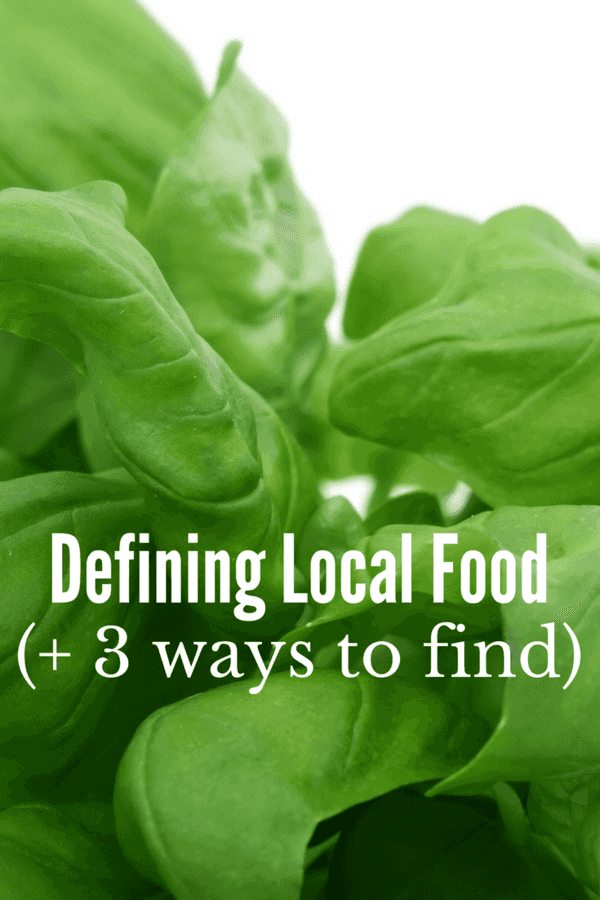
Locally sourced food is one of the cornerstones of healthier living ~ but… the definition of local may mean different things to different people.
We see “Buy local” everywhere, and “locally grown” added to many items at the grocery store. In fact, 5 years ago you may not have seen “local!” stamped on much of anything at your grocer, and now you can see full on signs behind every produce item and advertisements in the weekly flier that mention the produce coming from a local farmer.
The term “buy local” may mean different things to different people though ..
What defines local? Is it the distance from the community to the produce item? Or, does it apply to products that have many ingredients from many areas?
Does a small, family owned local farm 800 miles away still count as local food?
And when it comes to buying local, should it be sustainable or organic to earn the title “local”?
What exactly defines local?
I thought about that a great deal this week when talking to a friend ~ depending on who you ask, you might get a different opinion. Here are some things to think about:
1/3 of consumers see local as coming from within their state.
50% of consumers see local as coming from within a 100 mile radius of their location.
The USDA has no standard on what is considered local.
AASHE (Association for Advancement of Sustainability in Higher Education) defines local as 250 mile radius around their point of purchase. They also consider foods that are processed/purchased within 250 miles “local” too – even if they were grown 800 – 1000 miles away.
Whole Foods defines local as being within 200 miles of any particular store.
More and more people want to buy local ~ after all, it travels less time to it’s destination keeping produce fresher, longer, and with more nutrients. You can pick up more in terms of variety, and it helps you support farmers that have the same mindset you do – fresh, local produce grown with the help of nature.
Related: 8 Reasons to Buy Local Food
Two thirds of shoppers who buy local food do so in the supermarket or the grocery store. .. while many assume that local means organic, grown better or, small-operation.. when in many cases it’s not the case.
If you tend to be passionate about buying local, then you will be very selective about where you shop and pass forward your money – you will shop directly at the farm OR pick up your produce from a CSA.
Here are 3 ways to help you find your local food sources:
Research food co-ops in your area
Most major cities have a co-op or group that buys items in bulk with drops in your area. Co-ops exist to meet the needs of the citizens – from beans & legumes, to corn, flour & more.
Use the internet to find those contacts (Azure Standard is one that comes to mind) and determine who has a drop in your area that’s close to you so that you can order what you need and pick up in their area. You’ll get better prices buying in bulk through the group share.
Call the Farmers Market
Your local farmers market is a great place to start – the vendors at the farmers market are usually small farmers that sometimes sell items all year long. Some may offer raw dairy in the form of cow or goat’s milk, raw cheese, pastured meat, and even local, raw honey. You will often times be able to find local produce there for sale – not only by the pound but also in the form of a CSA bag.
By getting a hold of the vendors at the market, you might be able to work out a weekly commitment, get yourself on their produce share list or, pick up meat for a discount.
Research your Local Food Directory
A great place to start is Local Harvest or Agrilicious – which will help you link up with local contacts in your area that will allow you to find availability on local food.
There are also other sites you can visit to find farmers and local suppliers in your area:
There may be a few things at your grocery that come from local farmers .. but in most cases the food comes from a distance. It’s picked, and it travels in a dark truck to the store where it sits on shelves or in a produce area until it hits the sales floor days later. Or, in some cases, even a week later.
Once items are picked, they travel for up to a week before they reach the produce aisle. In the process, they have lost considerable nutrients (see this study here).
Every week, I pick up a CSA bag at my Farmers Market. I have noticed that the produce lasts SO much longer and is more vibrant than any of the produce at the store. One of my biggest gripes about grocery store produce is that it turns SO fast – both conventional AND organic.
It’s such a waste, but it’s reality – the items may be local, but they sit on the floor in the rear of the warehouse/store for a few days. My CSA sometimes picks spinach for me that same day of pick up – it doesn’t get any fresher than that.
Buying local [organic] isn’t necessarily more costly – in many cases, it’s less than your conventional grocery store. For an even better route to save, consider joining a CSA program – it’s an inexpensive, and affordable way to buy organic, local, seasonal produce all the while supporting your local farmers.




Leave a Reply
You must be logged in to post a comment.